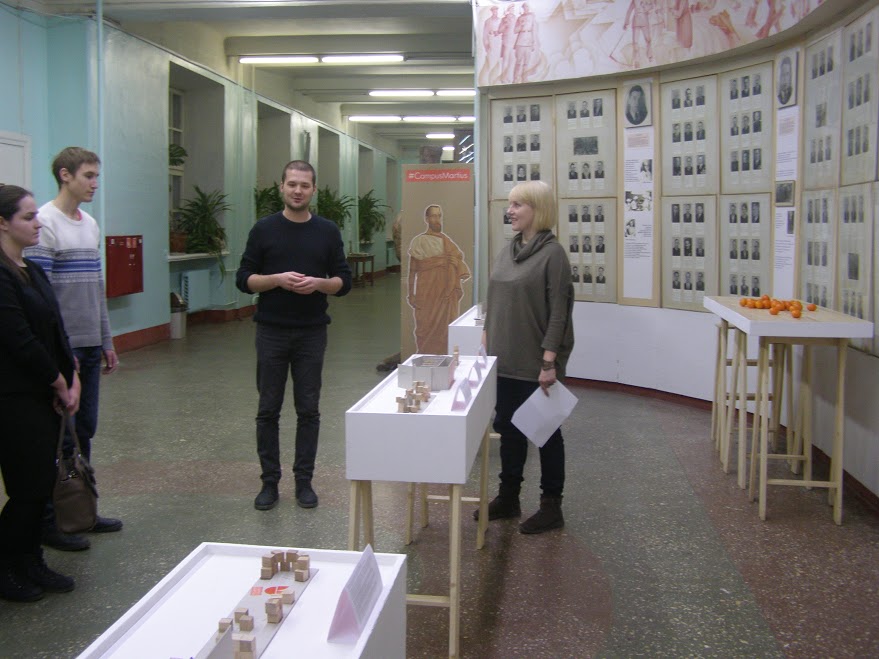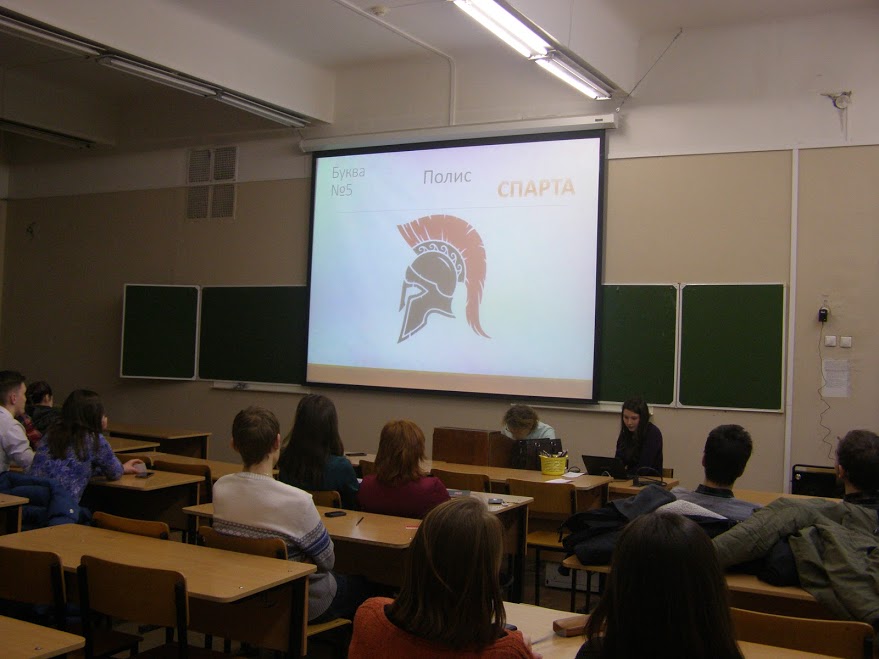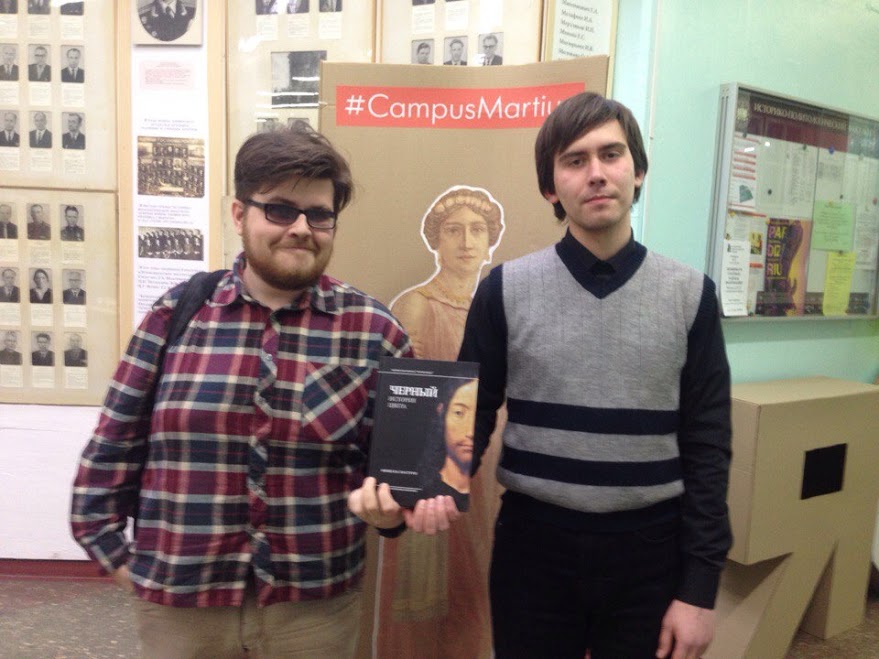
On February 8, 2017 two events organized by the Perm University History Museum were held. One of them was the opening of “Done!” exhibition of the recreational space at the entrance area. The wood and cardboard models made by the students of Perm State University and the graduates of other Perm universities were presented there. The models reproduced the ambience of antiquity. And the second event that took place that day was an intellectual game called “Azbuka” (or “ABC” in Russian).
“Done!” exhibition was placed on the 2nd floor of the Building No. 2 at the entrance to the Perm University History Museum. At the exhibition there were a lot of models made by the participants of the master class of Peter Stabrovsky, designer of the “Campus Martius, or How to Become a Citizen of Perm University” project. The mentioned master class had been held in December 2016 within the framework of the project «Peremena» (or “Break” in Russian) laboratory, devoted to the improvement of the recreational space near the Perm University History Museum and to learning more about being a citizen of Perm University. The students attending the master class had to do quite a difficult task: to create the models of recreational space at the entrance to the Perm University History Museum. The entrance area was intended to serve as a place where one can take a rest, gain knowledge and see the presented exhibitions. And the students were able to contribute to the upgrading of this area. However, there were some rules for the participants of how the models could be done. Thus, every person had to make their model within the limited space and using a certain amount of items: 20 wooden blocks and cardboard men. Also all the constructions were to relate to antiquity — the participants were to create the ambience of that era. Despite the fact that every student had the same materials, aims and theme (antiquity), each designer made their own unique model.


Denis, designer of one of the models, noted:
“The master class has given me the opportunity not only to think about how the recreational space should look but also it has allowed me to do the handiwork”.
During the next week everyone can visit the exhibition of the models of the recreational space at the entrance to the Perm University History Museum and know many interesting facts about the problems that the students of Perm State University and the graduates of other Perm universities tried to solve while they were creating the models for the recreational space.
“A teacher is always in the advantageous position in the sense that while you are resolving a difficult problem like, for example, the multifunctionality of this space, you are able to give tasks to the students and they will find many ways to deal with it. And they will solve it basing on their own vision and needs”,
— said Peter Stabrovsky, the designer of the “Campus Martius” project.

Maria Romashova, the director of the Perm University History Museum noted:
“In the end, many students’ ideas matched ours and some visuals, like the Greek columns, appeared in different models. This means there is a single vector of thinking and there are certain sub-themes relating to antiquity which seem interesting to the students”.
Every model has a label with the name of its author on the one side and the description of the model and starting points of the idea of the model on the other side.

While the exhibition is open, Peter Stabrovsky will make the last adjustments to the project of the recreational space and will show it to the public at the end of February.
After the opening of the exhibition an intellectual game called “Azbuka” was held in the auditorium No. 324 (Building No. 2, Perm State University). While playing the game, the participants could check who knew antique words and terms better and test how well they remembered maths and astronomy from school. Moreover, during the game the players tested how attentive they had been while visiting the History Museum.

The rules of the game are very simple. First of all, all the participants divided into groups of 1-4 persons. Each team got 3 sheets of paper (according to the number of game rounds). Every sheet had 7 letters and 21 words written. During each round pictures with short inscriptions were shown to the players. The participants were to guess which word best described the image and to write it on their piece of paper. All 3 words describing each of the 3 pictures started with the same letter. You can see 3 pictures below as an example. The words referring to them start with the same letter.
The next 3 words start with another letter. The letters never repeat during the game. The team that guesses the most words wins.
Sometimes the players gave very unusual variants for the words. For instance, some people wrote “trapeze” instead of “tetrahedron” (and it is fair to say that those were definitely very attentive at geometry lessons at school), “colouring book” in place of “catalog”, “Bohemia” and “Bulgaria” instead of “Bosporus”, “mantra” and not “mystery”, “okroshka (Russian national food) plate” in place of “oenochoe”.
There was a real competition between the teams: every group wanted to get the main prize — a recently published book “Black: The History of a Colour” by M. Pastoureau. The third place (52 points) was taken by the team called “We have written everything” made up of the members of Perm University Endowment Fund. The team “Non-epic brick”, consisted of the students of the History and Politology Department, was in the second place (56 points). The winner (57 points) of the game was the team “Professor Bubnov’s Children ”, the group of master students of The Theory and Practice of Applied History Master Programme.

The Perm University History Museum and the team of the “Campus Martius” project express their gratitude to all the visitors of the exhibition and all the participants of the intellectual game. You can learn more about the events of the “Campus Martius” project on our website, on social networks such as VK and Facebook and on Vladimir Potanin Foundation website (online-diary of the project).


